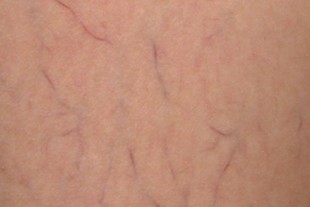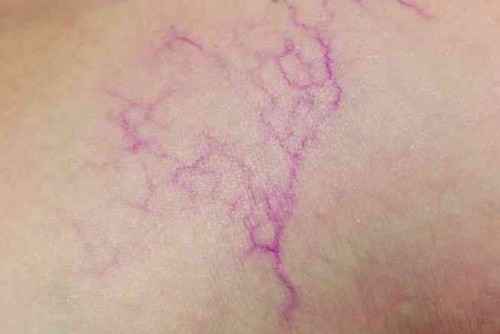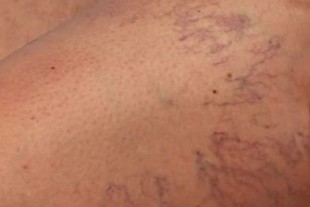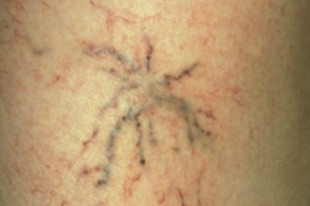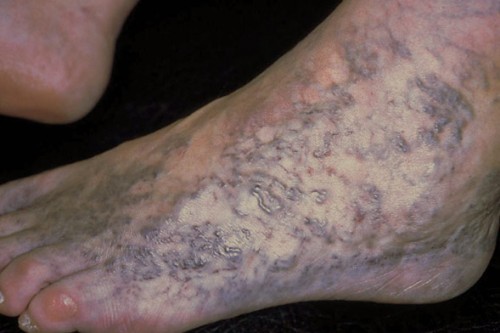40-60% of all women and men suffer from spider veins
Here you find detailed information about spider veins and their symptoms

Definition & occurrence of spider veins
With a diameter of less than 1 mm, spider veins are the miniature versions of varicose veins. The dilated, small veins lie within the skin and not beneath it like the large varicose veins. For this reason, the spider veins can be seen shimmering clearly through the skin, particularly in fair-skinned people. They can be found anywhere on the leg, but appear particularly frequently on the outer side of the lower leg and thigh and the inner side of the knee.
Spider veins may be bluish or reddish-purple in colour and have a dotted, stripy, fan-shaped, or star-like (starbursts) appearance. They may occur singly or in clusters and, in the worst cases, extend over a relatively large area on the leg.
Spider veins are usually considered to be purely an aesthetic problem, but they may be the first visible sign of venous insufficiency that will become worse with time. Pronounced spider veins may cause symptoms and may indicate that larger varicose veins are already present and possibly even be the cause of the spider veins.
Spider veins may occur on their own or together with large varicose veins.
The following photos show examples of spider veins:
Spider veins may also be very pronounced: in the case below, the spider veins are due to a diseased perforating vein (perforator) connecting the systems. This vein also needs to be treated as it is supplying the spider veins with blood.
A particularly severe form of spider veins on the foot is called corona phlebectatica. These spider veins are considered to be an early sign of advanced vein disease. A person with this condition should see a doctor without delay.
Reticular varicose veins
These small networks of varicose veins lie somewhat deeper in the skin than spider veins, but they often occur together and are frequently interconnected. Reticular varicose veins have a diameter of 1-3 mm and are slightly larger than spider veins. With their bluish or greenish-blue colour they are clearly visible.
Reticular veins tend to form a fan-like or netted appearance and, like spider veins, are often found on the sides of the upper and lower leg.
The following photos show examples of spider veins and reticular varicose veins occurring together:
In technical language, both spider veins and reticular veins are classified together in one group as C1 varicose veins. C1 covers the mildest form of varicose disease, generally considered as a cosmetic problem rather than a medical one.
Occurrence of spider veins
Spider veins are a common disease that affects more people than almost any other medical condition. The Bonn Vein Study (Rabe, Phlebologie 2003;32:1) showed that about 60% of adults in Germany have spider veins or reticular varicose veins, without having developed any large varicose veins. Of course, there is a wide diversity of manifestations here and this 60% includes single spider veins as well as more severe forms of disease. Somewhat surprisingly, men are affected by spider veins as often as women, although they seem to be less bothered by these unsightly dilated veins.
The incidence of varicose disease basically increases with age, but studies have shown that many young people are already affected by spider veins: about 14% of the under-30s in Germany have spider veins and even 2% of 18- to 19-year olds.
An international study (Rabe, International Angiology 2012;31:105) investigated whether vein disease is less common in the Far East than in the western world, as is often asserted. Although people in Germany seemed to be particularly frequently affected, spider veins and reticular veins are a worldwide problem. The disease affects about 43% of the adult population in Western Europe, 42% in Latin America, as high as 54% in the Middle East, and 45% in the Far East. Central and Eastern Europe come off best with only 38% of the population having the disease in these regions. And it should be mentioned that also 52% of people have spider veins in fashion-conscious California (Criqui, American Journal of Epidemiology 2001;158:448).
The studies therefore clearly demonstrate that small varicose veins are universal and not restricted to Western Europe, with developing countries, Asian countries, and the USA being equally affected.

